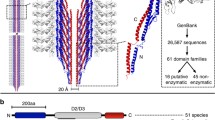Abstract
There is a growing interest in enterobacterial flagellins that may result in a demand to produce flagellin on an industrial scale for possible applications as an adjuvant, immunomodulatory agent or vaccine antigen. Traditionally, small-scale production of flagellin has occurred in the laboratory by flagellar shearing of bacterial surfaces and subsequent ultracentrifugation. The main drawback of this method is the need to use low-agitation cultures to avoid the loss of flagella due to shearing during culture. In the present work, we describe a scalable protocol for the production of flagellin with higher yields than traditional laboratory-scale protocols. The use of cross-flow filtration to concentrate bacterial cultures combines extensive shearing of flagella with a reduction in volume, greatly simplifying downstream processing. This technique also allows the use of highly-agitated culture conditions because any sheared flagella are retained in the bacterial concentrate. Flagella obtained with this procedure showed in vivo and in vitro innate activating capacities similar to those of flagella produced at laboratory scale. This procedure is flexible, allowing an increase in production scale, an enhancement of flagellin yield and no requirement for expensive equipment.



Similar content being viewed by others
References
Anderle P, Rumbo M, Sierro F, Mansourian R, Michetti P, Roberts MA, Kraehenbuhl JP (2005) Novel markers of the human follicle-associated epithelium identified by genomic profiling and microdissection. Gastroenterology 129(1):321–327
Brett PJ, Mah DC, Woods DE (1994) Isolation and characterization of Pseudomonas pseudomallei flagellin proteins. Infect Immun 62(5):1914–1919
Burdelya LG, Krivokrysenko VI, Tallant TC, Strom E, Gleiberman AS, Gupta D, Kurnasov OV, Fort FL, Osterman AL, Didonato JA, Feinstein E, Gudkov AV (2008) An agonist of toll-like receptor 5 has radioprotective activity in mouse and primate models. Science 320(5873):226–230
Honko AN, Sriranganathan N, Lees CJ, Mizel SB (2006) Flagellin is an effective adjuvant for immunization against lethal respiratory challenge with yersinia pestis. Infect Immun 74(2):1113–1120
Ibrahim GF, Fleet GH, Lyons MJ, Walker RA (1985) Method for the isolation of highly purified salmonella flagellins. J Clin Microbiol 22(6):1040–1044
Jones RM, Sloane VM, Wu H, Luo L, Kumar A, Kumar MV, Gewirtz AT, Neish AS (2011) Flagellin administration protects gut mucosal tissue from irradiation-induced apoptosis via MKP-7 activity (in press)
Kelly-Wintenberg K, Anderson T, Montie TC (1990) Phosphorylated tyrosine in the flagellum filament protein of Pseudomonas aeruginosa. J Bacteriol 172(9):5135–5139
Laemmli UK (1970) Cleavage of structural proteins during the assembly of the head of bacteriophage t4. Nature 227:680–685
Lane MC, Alteri CJ, Smith SN, Mobley HL (2007) Expression of flagella is coincident with uropathogenic escherichia coli ascension to the upper urinary tract. Proc Natl Acad Sci USA 104(42): 16669–16674. Epub 12007 Oct 16669
Lee SE, Kim SY, Jeong BC, Kim YR, Bae SJ, Ahn OS, Lee JJ, Song HC, Kim JM, Choy HE, Chung SS, Kweon MN, Rhee JH (2006) A bacterial flagellin, vibrio vulnificus flab, has a strong mucosal adjuvant activity to induce protective immunity. Infect Immun 74(1):694–702
Lightfield KL, Persson J, Brubaker SW, Witte CE, von Moltke J, Dunipace EA, Henry T, Sun YH, Cado D, Dietrich WF, Monack DM, Tsolis RM, Vance RE (2008) Critical function for naip5 in inflammasome activation by a conserved carboxy-terminal domain of flagellin. Nat Immunol 9(10): 1171–1178. Epub 2008 Aug 1124
Mahajan A, Currie CG, Mackie S, Tree J, McAteer S, McKendrick I, McNeilly TN, Roe A, La Ragione RM, Woodward MJ, Gally DL, Smith DG (2009) An investigation of the expression and adhesin function of h7 flagella in the interaction of Escherichia coli O157: H7 with bovine intestinal epithelium. Cell Microbiol 11(1):121–137
McNeilly TN, Naylor SW, Mahajan A, Mitchell MC, McAteer S, Deane D, Smith DG, Low JC, Gally DL, Huntley JF (2008) Escherichia coli O157:H7 colonization in cattle following systemic and mucosal immunization with purified h7 flagellin. Infect Immun 76(6):2594–2602
Miao EA, Andersen-Nissen E, Warren SE, Aderem A (2007) Tlr5 and ipaf: dual sensors of bacterial flagellin in the innate immune system. Semin Immunopathol 29(3):275–288
Mizel SB, Bates JT (2010) Flagellin as an adjuvant: cellular mechanisms and potential. J Immunol 185(10):5677–5682
Montie TC, Stover GB (1983) Isolation and characterization of flagellar preparations from Pseudomonas species. J Clin Microbiol 18(3):452–456
Nempont C, Cayet D, Rumbo M, Bompard C, Villeret V, Sirard JC (2008) Deletion of flagellin’s hypervariable region abrogates antibody-mediated neutralization and systemic activation of tlr5-dependent immunity. J Immunol 181(3):2036–2043
Rumbo M, Sierro F, Debard N, Kraehenbuhl JP, Finke D (2004) Lymphotoxin beta receptor signaling induces the chemokine ccl20 in intestinal epithelium. Gastroenterology 127(1):213–223
Rumbo M, Nempont C, Kraehenbuhl JP, Sirard JC (2006) Mucosal interplay among commensal and pathogenic bacteria: lessons from flagellin and toll-like receptor 5. FEBS Lett 580(12): 2976–2984. Epub 2006 Apr 2921
Saxena A, Tripathi BP, Kumar M, Shahi VK (2009) Membrane-based techniques for the separation and purification of proteins: an overview. Adv Colloid Interface Sci 145(1–2):1–22
Sierro F, Dubois B, Coste A, Kaiserlian D, Kraehenbuhl JP, Sirard JC (2001) Flagellin stimulation of intestinal epithelial cells triggers ccl20-mediated migration of dendritic cells. Proc Natl Acad Sci USA 98(24):13722–13727
Skountzou I, Martin MD, Wang B, Ye L, Koutsonanos D, Weldon W, Jacob J, Compans RW (2010) Salmonella flagellins are potent adjuvants for intranasally administered whole inactivated influenza vaccine. Vaccine 28(24):4103–4112
Strindelius L, Filler M, Sjoholm I (2004) Mucosal immunization with purified flagellin from salmonella induces systemic and mucosal immune responses in c3 h/hej mice. Vaccine 22(27–28):3797–3808
Acknowledgments
This work was supported by grant INCO FP6-CT 032296 to National University of La Plata and BIOL SAIC to MR and JCL. YH is a fellow from Consejo Nacional de Investigaciones Científicas y Técnicas (CONICET). AE is a fellow from ANPCYT. MR is a member of the Scientific Carreer of CONICET.
Conflict of interest
The authors declare that they have no conflict of interest.
Author information
Authors and Affiliations
Corresponding author
Rights and permissions
About this article
Cite this article
Hiriart, Y., Errea, A., González Maciel, D. et al. A method for the purification of bacterial flagellin that allows simple upscaling. World J Microbiol Biotechnol 28, 15–21 (2012). https://doi.org/10.1007/s11274-011-0786-3
Received:
Accepted:
Published:
Issue Date:
DOI: https://doi.org/10.1007/s11274-011-0786-3




